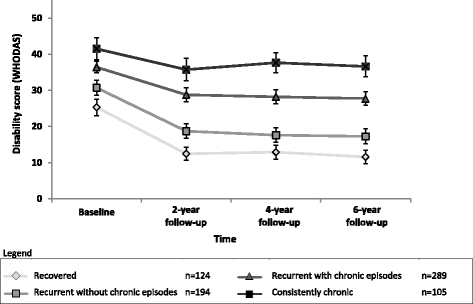Reconsidering the prognosis of major depressive disorder across diagnostic boundaries: full recovery is the exception rather than the rule
- PMID: 29228943
- PMCID: PMC5725897
- DOI: 10.1186/s12916-017-0972-8
Reconsidering the prognosis of major depressive disorder across diagnostic boundaries: full recovery is the exception rather than the rule
Abstract
Background: Major depressive disorder (MDD) is often handled as an episodic and isolated disorder, resulting in an optimistic view about its prognosis. Herein, we test the idea that the prognosis of MDD changes if we vary the perspective in terms of (1) a longer time frame and (2) a broader diagnostic conceptualisation including dysthymia, (hypo)mania and anxiety disorders as relevant outcomes.
Methods: Patients with current MDD at baseline (n = 903) and available 2-, 4-, and/or 6-year follow-up assessments were selected from the Netherlands Study of Depression and Anxiety, a psychiatric cohort study. Combining psychiatric DSM-IV-based diagnoses and life-chart data, patient course trajectories were classified as (1) recovered (no diagnoses at 2-year follow-up or thereafter), (2) recurrent without chronic episodes, (3) recurrent with chronic episodes or (4) consistently chronic since baseline. A chronic episode was defined as having a current diagnosis at the follow-up assessment and consistent symptoms over 2 years. Proportions of course trajectories were provided moving from a short, narrow perspective (2-year follow-up, considering only MDD diagnosis) to a long, broad perspective (6-year follow-up, including MDD, dysthymia, (hypo)mania and anxiety diagnoses).
Results: With the short, narrow perspective, the recovery rate was 58% and 21% had a chronic episode. However, in the long, broad perspective the recovery rate was reduced to 17%, while 55% of the patients experienced chronic episodes.
Conclusions: Results from a long and rigorous follow-up in a large cohort suggests that most MDD patients have an unfavourable prognosis. Longer follow-up and broader diagnostic conceptualisation show that the majority of patients have a disabling and chronic disorder. Conceptualising and handling MDD as a narrowly defined and episodic disorder may underestimate the prognosis of the majority of depressed patients and, consequently, the type of care that is appropriate.
Keywords: Affective disorder; Anxiety disorder; Comorbidity; Course; Longitudinal; Major depressive disorder; Prognosis.
Conflict of interest statement
Ethics approval and consent to participate
The NESDA study was approved by the Medical Ethical Review Boards (in Dutch: Medisch Ethische Toetsingscommissie or METc) of the VU University Medical Center, the University Medical Center Groningen and the Leiden University Medical Center. All participants signed informed consent.
Consent for publication
Not applicable.
Competing interests
The authors declare that they have no competing interests.
Publisher’s Note
Springer Nature remains neutral with regard to jurisdictional claims in published maps and institutional affiliations.
Figures


Similar articles
-
[Complete recovery from depression is the exception rather than the rule: prognosis of depression beyond diagnostic boundaries].Ned Tijdschr Geneeskd. 2018 Sep 6;162:D2920. Ned Tijdschr Geneeskd. 2018. PMID: 30306757 Dutch.
-
How chronic are depressive and anxiety disorders? 9-year general population study using narrow and broad course outcomes.J Affect Disord. 2022 Nov 15;317:149-155. doi: 10.1016/j.jad.2022.08.083. Epub 2022 Aug 27. J Affect Disord. 2022. PMID: 36031004
-
Associations between age and the course of major depressive disorder: a 2-year longitudinal cohort study.Lancet Psychiatry. 2018 Jul;5(7):581-590. doi: 10.1016/S2215-0366(18)30166-4. Epub 2018 Jun 18. Lancet Psychiatry. 2018. PMID: 29887519
-
Mixed features in major depressive disorder: diagnoses and treatments.CNS Spectr. 2017 Apr;22(2):155-160. doi: 10.1017/S1092852917000256. CNS Spectr. 2017. PMID: 28462772 Review.
-
ECNP consensus meeting. Bipolar depression. Nice, March 2007.Eur Neuropsychopharmacol. 2008 Jul;18(7):535-49. doi: 10.1016/j.euroneuro.2008.03.003. Epub 2008 May 23. Eur Neuropsychopharmacol. 2008. PMID: 18501566 Review.
Cited by
-
Remote Assessment of Disease and Relapse in Major Depressive Disorder (RADAR-MDD): recruitment, retention, and data availability in a longitudinal remote measurement study.BMC Psychiatry. 2022 Feb 21;22(1):136. doi: 10.1186/s12888-022-03753-1. BMC Psychiatry. 2022. PMID: 35189842 Free PMC article.
-
Intergenerational transmission of lifetime stressor exposure in adolescent girls at differential maternal risk for depression.J Clin Psychol. 2023 Feb;79(2):431-448. doi: 10.1002/jclp.23417. Epub 2022 Jul 23. J Clin Psychol. 2023. PMID: 35869956 Free PMC article.
-
The GET READY relapse prevention programme for anxiety and depression: a mixed-methods study protocol.BMC Psychiatry. 2019 Feb 11;19(1):64. doi: 10.1186/s12888-019-2034-6. BMC Psychiatry. 2019. PMID: 30744601 Free PMC article.
-
Cost-effectiveness and threshold analysis of deep brain stimulation vs. treatment-as-usual for treatment-resistant depression.Transl Psychiatry. 2024 Jun 7;14(1):243. doi: 10.1038/s41398-024-02951-7. Transl Psychiatry. 2024. PMID: 38849334 Free PMC article.
-
Automated mood disorder symptoms monitoring from multivariate time-series sensory data: getting the full picture beyond a single number.Transl Psychiatry. 2024 Mar 26;14(1):161. doi: 10.1038/s41398-024-02876-1. Transl Psychiatry. 2024. PMID: 38531865 Free PMC article.
References
-
- Emil K. Psychiatry: A Textbook for Students and Physicians - Vol 2: Clinical Psychiatry (Resources in medical history) Sagamore Beach, MA: Science History Publications; 1990.
-
- Frank E, Kupfer DJ. Maintenance treatment of recurrent unipolar depression: pharmacology and psychotherapy. Adv Biochem Psychopharmacol. 1985;40:139–51. - PubMed
MeSH terms
Grants and funding
LinkOut - more resources
Full Text Sources
Other Literature Sources

